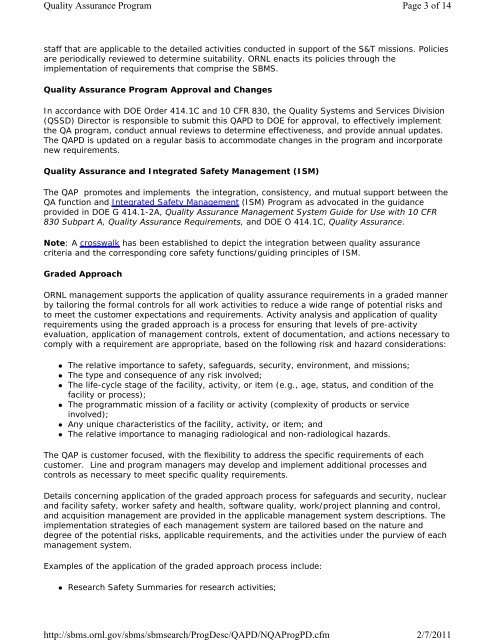Quality Assurance Program - Oak Ridge National Laboratory
Quality Assurance Program - Oak Ridge National Laboratory
Quality Assurance Program - Oak Ridge National Laboratory
You also want an ePaper? Increase the reach of your titles
YUMPU automatically turns print PDFs into web optimized ePapers that Google loves.
<strong>Quality</strong> <strong>Assurance</strong> <strong>Program</strong><br />
http://sbms.ornl.gov/sbms/sbmsearch/ProgDesc/QAPD/NQAProgPD.cfm<br />
Page 3 of 14<br />
2/7/2011<br />
staff that are applicable to the detailed activities conducted in support of the S&T missions. Policies<br />
are periodically reviewed to determine suitability. ORNL enacts its policies through the<br />
implementation of requirements that comprise the SBMS.<br />
<strong>Quality</strong> <strong>Assurance</strong> <strong>Program</strong> Approval and Changes<br />
In accordance with DOE Order 414.1C and 10 CFR 830, the <strong>Quality</strong> Systems and Services Division<br />
(QSSD) Director is responsible to submit this QAPD to DOE for approval, to effectively implement<br />
the QA program, conduct annual reviews to determine effectiveness, and provide annual updates.<br />
The QAPD is updated on a regular basis to accommodate changes in the program and incorporate<br />
new requirements.<br />
<strong>Quality</strong> <strong>Assurance</strong> and Integrated Safety Management (ISM)<br />
The QAP promotes and implements the integration, consistency, and mutual support between the<br />
QA function and Integrated Safety Management (ISM) <strong>Program</strong> as advocated in the guidance<br />
provided in DOE G 414.1-2A, <strong>Quality</strong> <strong>Assurance</strong> Management System Guide for Use with 10 CFR<br />
830 Subpart A, <strong>Quality</strong> <strong>Assurance</strong> Requirements, and DOE O 414.1C, <strong>Quality</strong> <strong>Assurance</strong>.<br />
Note: A crosswalk has been established to depict the integration between quality assurance<br />
criteria and the corresponding core safety functions/guiding principles of ISM.<br />
Graded Approach<br />
ORNL management supports the application of quality assurance requirements in a graded manner<br />
by tailoring the formal controls for all work activities to reduce a wide range of potential risks and<br />
to meet the customer expectations and requirements. Activity analysis and application of quality<br />
requirements using the graded approach is a process for ensuring that levels of pre-activity<br />
evaluation, application of management controls, extent of documentation, and actions necessary to<br />
comply with a requirement are appropriate, based on the following risk and hazard considerations:<br />
• The relative importance to safety, safeguards, security, environment, and missions;<br />
• The type and consequence of any risk involved;<br />
• The life-cycle stage of the facility, activity, or item (e.g., age, status, and condition of the<br />
facility or process);<br />
• The programmatic mission of a facility or activity (complexity of products or service<br />
involved);<br />
• Any unique characteristics of the facility, activity, or item; and<br />
• The relative importance to managing radiological and non-radiological hazards.<br />
The QAP is customer focused, with the flexibility to address the specific requirements of each<br />
customer. Line and program managers may develop and implement additional processes and<br />
controls as necessary to meet specific quality requirements.<br />
Details concerning application of the graded approach process for safeguards and security, nuclear<br />
and facility safety, worker safety and health, software quality, work/project planning and control,<br />
and acquisition management are provided in the applicable management system descriptions. The<br />
implementation strategies of each management system are tailored based on the nature and<br />
degree of the potential risks, applicable requirements, and the activities under the purview of each<br />
management system.<br />
Examples of the application of the graded approach process include:<br />
• Research Safety Summaries for research activities;

















